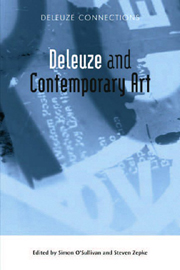Book contents
- Frontmatter
- Contents
- Acknowledgements
- List of Illustrations
- Introduction: Deleuze and Guattari and Contemporary Art
- POLITICS
- THE AESTHETIC PARADIGM
- SCENES AND ENCOUNTERS
- 9 An Art Scene as Big as the Ritz: The Logic of Scenes
- 10 Abstract Humour, Humorous Abstraction
- 11 From Aesthetics to the Abstract Machine: Deleuze, Guattari and Contemporary Art Practice
- 12 Traps Against Capture
- TECHNOLOGIES
- Notes on Contributors
- Index
9 - An Art Scene as Big as the Ritz: The Logic of Scenes
from SCENES AND ENCOUNTERS
Published online by Cambridge University Press: 12 September 2012
- Frontmatter
- Contents
- Acknowledgements
- List of Illustrations
- Introduction: Deleuze and Guattari and Contemporary Art
- POLITICS
- THE AESTHETIC PARADIGM
- SCENES AND ENCOUNTERS
- 9 An Art Scene as Big as the Ritz: The Logic of Scenes
- 10 Abstract Humour, Humorous Abstraction
- 11 From Aesthetics to the Abstract Machine: Deleuze, Guattari and Contemporary Art Practice
- 12 Traps Against Capture
- TECHNOLOGIES
- Notes on Contributors
- Index
Summary
Introduction: Art + Life = Scene
How did it happen? How did the problem of the separation of art and life, essential to the development of avant-garde art, come to be overshadowed by concerns for criticality and taste? No doubt critical postmodernism – the drive to emphasise the place of art within cultural, socio-economic and institutional frameworks – and the heady cocktail of creativity and celebrity promoted by the art market in the 1980s both played a part in eclipsing the problem of the sublation of art and life. Perhaps too, the critique of avant-garde groups – the dismissal of their Popes and claims for originality – cast a shadow over practices that sought a basis for life in art. Most likely, it was the collapse of avant-garde politics that rendered this problem a vanishing mediator for many.
The sublation of art and life – art ‘transferred to the praxis of life’, thus transforming both – was identified as the primary theme of the historical European avant-garde by Peter Bürger (1989: 49). Bürger argued that the advent of avant-garde art marked a rejection of art for art's sake. This rejection was twofold: not only a refusal of everyday life produced by capitalism but a refusal too of the separation of art and life that characterised bourgeois art. To this end, comments Bürger, the avant-garde addressed an essential element of aestheticism: the presentation of art's distance from the praxis of life as the content of art (Bürger 1989: 49).
- Type
- Chapter
- Information
- Deleuze and Contemporary Art , pp. 157 - 175Publisher: Edinburgh University PressPrint publication year: 2010

